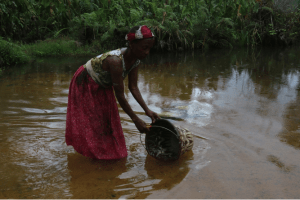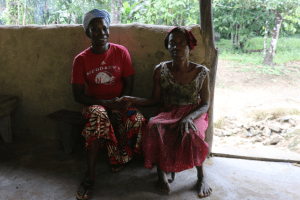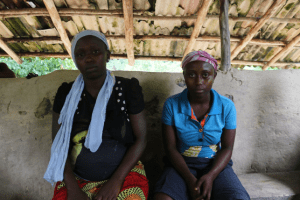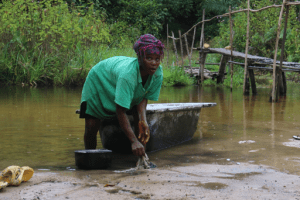Morris Town, Bomi County – Watta Kanneh, 68, struggles to draw water from a creek next to towering palm trees, where she and other villagers make palm oil in two blackened drums sitting over huge fire hearths. Kanneh still suffers from wounds she received 16 years ago during the 2003 killings that became known as the Maher Massacre. Long scars on her back peek out from a sleeveless blouse. The tight scar tissue makes it difficult for her to lift the bucket.

This story first appeared on FrontPageAfricaOnline as part of a collaboration for the West Africa Justice Reporting Project.
The 2002 Maher Massacre is one of the last mass killings of the Liberian civil war (1989 – 2003). Kanneh lost 13 relatives in the massacre: her husband, four sons, a daughter, a daughter-in-law and six grandchildren, including a one-week-old baby. Just five survived. “Hundreds” of people were killed in the massacre, according to the Catholic Justice of the Peace Commission (JPC) two years after the massacre.
Kanneh and family are some of the survivors of hundreds of massacres that took place during Liberia’s civil war. It has been 15 years since the war ended, but no survivor has been compensated. Neither has anyone been prosecuted in Liberia for any crimes committed during the war.
Morris Town is a remote village in the Senjeh District some 10 kilometers from Tubmanburg—the capital of Liberia’s poorest county. Kanneh struggles daily to make ends meet, growing impatient as the years go by. The widow wants the government of Liberia to assist her family now that she still has breath. “I am old now,” Kanneh laments. “I am not abled. If they want to help me, they can help me,” she says.
“I just want to tell the government to help us,” echoes Alice Ballah, 38, one of Kanneh’s daughters who also survived the massacre.
Alice says the family also wants justice. “Let them carry them (masterminds) to court, because the thing that they did to us was bad,” Alice adds.
The 2004 JPC investigation blamed Benjamin Yeaten, former Director of the defunct Special Security Service (now known as the Executive Protection Service) and former Director of Port Security Roland Duo for masterminding the killings. The Truth and Reconciliation Commission (TRC) also listed the two men among 98 “most notorious perpetrators” of the Liberian civil war.
Both men have denied the allegation. Former President Taylor dismissed that the massacre even took place during his war crimes trial in The Hague.
Several witnesses to the massacre gave testimonies to the Liberian Truth and Reconciliation Commission (TRC). It recommended compensation for survivors and victims. To date that has not happened.
The TRC’s recommendation for prosecutions for war crimes and crimes against humanity has also not been implemented.
The Liberian government in August this year reopened Yeaten’s indictment over the murder of former government officials—John Yormie and Isaac Vaye. He is reported to be hiding somewhere in the West African region, according to a 2017 report by Nigeria’s African Orbit.
Meanwhile a monument is being erected adjacent the Maher Bridge to the memory of victims of the massacre. The Independent Human Rights Commission funds it. It has been under construction for three years now.
Deadly Journey to Monrovia
In July 2002, militiamen loyal to the government of President Charles Taylor recaptured Bomi County, which had been under the control of rebels of the Liberia United for Democracy and Reconciliation (LURD). They suspected civilians of conniving with the rebels, so they plotted to kill them.

The militiamen made people gather from several towns and villages in Tubmanburg—the capital of the western county—and told them they were taking them to Monrovia, away from the crossfire. Kanneh and her family —who were regularly intimidated by the LURD rebels—seized the opportunity to leave Bomi she says. It was Thursday, July 18, 2002.
People gathered at a particular building according to witnesses. The militiamen registered names and placed them into groups of men, women and children, and the elderly. The first trip to Monrovia began by 5 pm.
But the militiamen were deceiving the people. They were actually taking them to be killed on Maher Bridge in Maher Town, some 60 kilometers from Monrovia. Witnesses say some were beheaded, some stabbed, some shot and the children thrown in the Maher River beneath the bridge. A 2016 award-winning movie “Maher: Black Rain in Bomi” is based on the story.
Kanneh says she discovered the plot once they arrived on the bridge. There were bloodstains on the ground and bodies in the river, she says. “[While] in the car, I was not to myself. I was crying for my children,” Kanneh recalls. “I was asking myself, ‘They (my family) are living or what?’”
It was already nightfall when the car was back from the bridge for Kanneh and other elderly people, she says. She watched in horror as the militiamen shot her husband to death. Now it was her turn.
“Then the boy hold my hand,” Kanneh recalls, fighting back tears. “He say ‘Come down [from the car], we are coming to do your own. The big man was in the car. He say ‘Y’all make it quick, quick,’” she narrates. The militiamen stabbed Kanneh twice on her back, causing her to vomit blood and pass out. He then threw the unconscious woman into the river.
Rescued in the forest
But Kanneh did not die. She says she must have floated to the riverbank where she woke up. She managed to walk into the dark forest.
After walking for sometime she stumbled upon two women. The women had been hiding in the forest for months from the pro-government militia and the LURD rebels.
“They (the women) wanted to run away,” Kanneh says. “I say ‘Y’all don’t run away. They…killed my husband and my children…’”
One of the women was the daughter of Mammie Bernard whom Kanneh had known since 1993. By then, her white blouse had turned red with blood, Bernard recalls. “My friends called me on the side and ask me ‘You able this woman?’” Bernard, 45 then adds. “I was depending on God, and I have human feelings.”
The two are meeting today for the first time in 4 years. There were hugs and tears as the two women recalled those terrible days. Bernard recalls treating Kanneh with herbs. “I made hot water and I warmed that sore,” Bernard says. “The bad blood was there, I moved everything.”
They hid in the forest for two months until Kanneh’s wounds healed.
Survival
Finally Kanneh traveled to Monrovia. She stayed at a displaced camp in Brewerville.
There, Kanneh found her daughter, Alice. Alice had also survived the massacre. Each thought the other had been killed. It was an emotional reunion.
“I started crying,” Alice remembers. “The sore was still on her back.”
Alice says she had been saved by one of the soldiers. He, like her, was from the Kpelleh tribe. For this reason he took her beneath the bridge where he pretended to kill her but instead allowed her to hide. He later took Alice to his girlfriend in a nearby village. The good militiamen’s girlfriend also rescued Sianeh, the daughter of one of Kanneh’s four sons who were killed in the massacre. The militiamen had thrown Sianeh into the river to drown like the other children whose corpses littered the dusky waterfront. When the Kpelle soldier heard Sianeh, then four years old, crying in the river, he rescued her, too.
The Kpelle militiaman took Alice and Sianeh to Careysburg and cared for them. She says she has never seen him since the end of the war. She gave birth to Cecelia four months later in the displaced camp where she had reunited with her mother.

It wasn’t only Alice and Sianeh who survived the massacre. Kanneh’s youngest child—Fatu Ballah, then 16, also survived.
Fatu says she first lived with one of the militiamen who went by the alias “Busy Boy”. He made her cook and clean like most “bush wives” but Fatu says he did not force her to have sex with him. They lived in Congo Town in the then unfinished Ministry of Health building. Kanneh visited Fatu once but could not take her with her, Fatu says. Busy Boy kept Fatu from seeing anyone. He threatened he would kill her if she told anyone what had happened at Maher.
“I was afraid in my body,” Fatu recalls. “I stood and looked at the old ma then I entered back in the house. When the old ma [saw] me, the old ma started crying then I started crying, too,” she continues.

She rejoined her family two years after the Maher Massacre
Fatu says she was only able to rejoin her family in Morris Town after Busy Boy died in La Côte d’Ivoire and her other abductor – she only knew him by his alias “High Command”- ran for his life after Yeaten killed his wife. Yeaten began hunting down people knowledgeable of his crimes, Fatu explains and High Command had been one of Yeaten’s bodyguards. Fatus says she then heard from some of the militiamen that Yeaten fled into exile shortly, disguising himself as a woman.
Today, Fatu is happy that she still has Kanneh, Alice, Sianeh and Cecelia around, but they all have to relive the horrors of the Maher Massacre each day. They are still waiting for reparation and justice but for them, life will never be the same.
